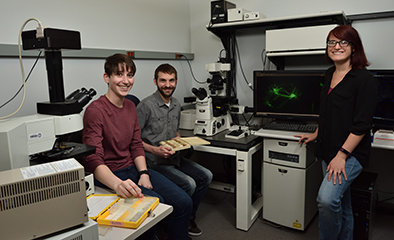CBMP Faculty
Shivalingappa Swamynathan, Ph.D.

Department: Ophthalmology
Email: swamynathansk@upmc.edu
PubMed: Link
Dept / Lab Webpage: http://ophthalmology.pitt.edu/people/shivalingappa-shiva-swamynathan-phd
CBMP groups: DNA Damage/Repair, Cell-Cycle Control and Gene Expression, Cancer, Cellular Injury, Wound Healing, Aging and Tissue Regeneration
Research Interests
Regulation of Gene Expression During Ocular Surface Development
Role of Kruppel-like zinc-finger transcription factors in the mouse ocular surface:
In the mouse, following eye opening around 2 weeks after birth, cells in the 1-2 cell layered epithelium proliferate and differentiate to form a 4-5 cell layered stratified squamous epithelium by 20 days after birth. The mature corneal epithelium containing 5-8 cell layers is present by 6 to 8 weeks after birth. Kruppel-like transcription factors KLF4 and KLF5 are among the most abundant transcription factors in the post-natal day 9 and 6 week old mouse cornea. Considering that Klf4 null mice die before mature cornea is formed, we have resorted to conditional deletion of Klf4 gene in the surface ectoderm- derived tissues of the eye (lens, cornea, conjunctiva and eyelids) by mating KLF4-loxP mice with Le-Cre mice.
Klf4 conditional null (Klf4CN) mice display normal viability and fertility, a rough, speckled ocular surface devoid of conjunctival goblet cells, hyperplastic iris and a spongy, vacuolated lens. Unlike the wild type, Klf4CN cornea possesses 3-4 epithelial cell layers, swollen, vacuolated basal epithelial cells and edematous stroma. Epithelial fragility and excessive cell sloughing result in fewer cell layers in spite of increased cell proliferation at the Klf4CN ocular surface. Expression of aquaporin-5 and keratin-12 is downregulated, consistent with the Klf4CN stromal edema and epithelial fragility. Our results provide new insights into the role of KLF4 in post-natal maturation of the ocular surface and suggest that the Klf4CN mouse is a useful model system for investigating ocular surface pathologies such as dry eye, Meesmann's dystrophy and Stevens-Johnson syndrome. By microarray comparison of gene expression, we have identified several other KLF4 target genes, revealing the molecular basis for diverse functions of KLF4 in the development and maintenance of cornea. We plan to use the Klf4CN mice to identify the genes whose expression is required in the conjunctival epithelium, for proper development of mucin secreting goblet cells.
A similar strategy as above will be utilized to generate Klf5 conditional null mice. Klf5 conditional null mice will be characterized in a similar manner as described above for Klf4CN mice. Eventually, we plan to generate Klf4 and Klf5 double conditional null mice, to identify any overlapping or antagonistic effects of these factors. These experiments will allow us to identify the target genes of KLF4 and KLF5, and define their role in regulation of maturation and maintenance of the mouse ocular surface.
